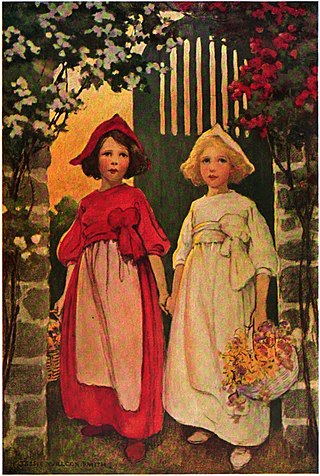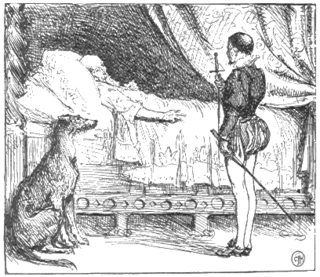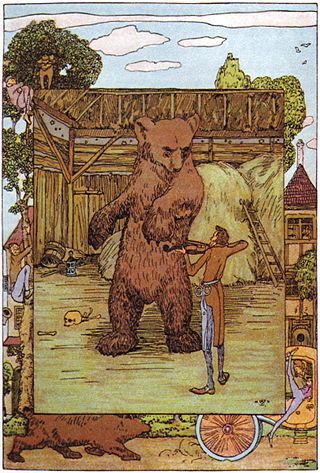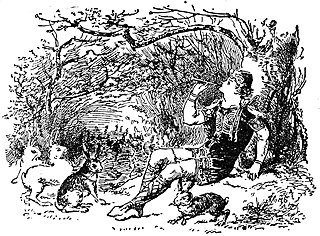Related Research Articles

"Snow-White and Rose-Red" is a German fairy tale. The best-known version is the one collected by the Brothers Grimm in 1837 in the third edition of their collection Grimm's Fairy Tales. An older, somewhat shorter version, "The Ungrateful Dwarf", was written by Caroline Stahl (1776–1837). Indeed, that appears to be the oldest variant; no previous oral version is known, although several have been collected since its publication in 1818. Oral versions are very limited regionally. The tale is of Aarne-Thompson type 426.

"Brother and Sister" is a European fairy tale which was, among others, written down by the Brothers Grimm. It is a tale of Aarne–Thompson Type 450. In Russia the story was more commonly known as "Sister Alionushka, Brother Ivanushka", and collected by Alexander Afanasyev in his Narodnye russkie skazki.

"The Blue Bird" is a French literary fairy tale by Madame d'Aulnoy, published in 1697. An English translation was included in The Green Fairy Book, 1892, collected by Andrew Lang.

The Story of Pretty Goldilocks or The Beauty with Golden Hair is a French literary fairy tale written by Madame d'Aulnoy. Andrew Lang included it in The Blue Fairy Book.

"Trusty John", "Faithful John", "Faithful Johannes", or "John the True" is a German fairy tale collected by the Brothers Grimm and published in Grimm's Fairy Tales in 1819. Andrew Lang included it in The Blue Fairy Book.

Graciosa and Percinet is a French literary fairy tale by Madame d'Aulnoy. Andrew Lang included it in The Red Fairy Book.
The Ram is a French literary fairy tale by Madame d'Aulnoy.

"The Clever Little Tailor" is a German fairy tale collected by the Brothers Grimm as tale 114. It is Aarne-Thompson type 850, The Princess's Birthmarks. Andrew Lang included it in The Green Fairy Book.

"The Peasant's Wise Daughter", "The Peasant's Clever Daughter" or "The Clever Lass" is a German fairy tale collected by the Brothers Grimm in Grimm's Fairy Tales as tale number 94. It has also spread into Bohemia and Božena Němcová included it into her collection of Czech national folk tales in 1846.
Little Johnny Sheep-Dung is a French fairy tale collected by Achille Millien and Paul Delarue.

Jesper Who Herded the Hares is a Scandinavian fairy tale, first recorded by Danish folktale collector Evald Tang Kristensen in the first volume of Æventyr fra Jylland. Andrew Lang included it in The Violet Fairy Book.

Grateful dead is both a motif and a group of related folktales present in many cultures throughout the world.
Le Serpentin Vert is a French fairy tale written by Marie Catherine d'Aulnoy, popular in its day and representative of European folklore, that was published in her book New Tales, or Fairies in Fashion, in 1698. The serpent is representative of a European dragon. His description is: "he has green wings, a many-coloured body, ivory jaws, fiery eyes, and long, bristling hair."

"Puss in Boots" is a European fairy tale about an anthropomorphic cat who uses trickery and deceit to gain power, wealth, and the hand in marriage of a princess for his penniless and low-born master.
Fairer-than-a-Fairy or More Beautiful Than Fairy is a literary fairy tale by Charlotte-Rose de Caumont de La Force in 1698.
Paul Alfred Delarue, born 20 April 1889 in Saint-Didier, Nièvre, died 25 July 1956 in Autun, Saône-et-Loire, was a French folklorist.
The Calumniated Wife is a motif in traditional narratives, numbered K2110.1 in Stith Thompson's Motif-Index of Folk-Literature. It entails a wife being falsely accused of, and often punished for, some crime or sin. This motif is at the centre of a number of traditional plots, being associated with tale-types 705–712 in the Aarne–Thompson–Uther Index of tale-types.
In folkloristics, "The Animal as Bridegroom" refers to a group of folk and fairy tales about a human woman marrying or being betrothed to an animal. The animal is revealed to be a human prince in disguise or under a curse. Most of these tales are grouped in the international system of Aarne-Thompson-Uther Index under type ATU 425, "The Search for the Lost Husband". Some subtypes exist in the international classification as independent stories, but they sometimes don't adhere to a fixed typing.
The Story of Princess Zeineb and King Leopard is a French language fairy tale published in the 18th century. The tale belongs to the international cycle of the Animal as Bridegroom as a subtype, with few variants reported across Europe.
Marie-Louise Tenèze née Alterauge (1922–2016) was a French ethnologist and folklorist who is remembered for her research into popular French fairy tales, including those transmitted by word of mouth. Inspired by Paul Delarue in the 1950s, in 2000 she completed his Le Conte populaire français : catalogue raisonné des versions de France et des pays de langue française d'outre-mer. She also collaborated with researchers from Göttingen on the Enzyklopädie des Märchens, published by De Gruyter. In collaboration with the ethnologist Jean-Michel Guilcher she investigated traditional dances. Working in particular with Josiane Bru, she devoted the remainder of her life to investigating the history of oral tales and traditions.
References
- ↑ Shimer, Edgar Dubs. Fairy stories my children love best of all. New York: L. A. Noble. 1920. pp. 89-101.
- ↑ Aarne, Antti; Thompson, Stith. The types of the folktale: a classification and bibliography. Folklore Fellows Communications FFC no. 184. Helsinki: Academia Scientiarum Fennica, 1961. pp. 248–249.
- ↑ Thompson, Stith (1977). The Folktale. University of California Press. pp. 77-78. ISBN 0-520-03537-2.
- ↑ Delarue, Paul; Ténèze, Marie-Louise (1957). Le conte populaire français; catalogue raisonné des versions de France et des pays de langue française d'outre-mer: Canada, Louisiane, îlots français des États-Unis, Antilles françaises, Haïti, Ile Maurice, La Réunion (in French). Érasme. p. 672. ISBN 978-2-7068-0623-0. OCLC 1625284.
- ↑ Thompson, Stith (1977). The Folktale. University of California Press. p. 183. ISBN 0-520-03537-2.
- ↑ Delarue, Paul; Ténèze, Marie-Louise (1957). Le conte populaire français; catalogue raisonné des versions de France et des pays de langue française d'outre-mer: Canada, Louisiane, îlots français des États-Unis, Antilles françaises, Haïti, Ile Maurice, La Réunion (in French). Érasme. p. 687. ISBN 978-2-7068-0623-0. OCLC 1625284.
- ↑ "The Story of the Little Half-Cock". In: Ridder, André de. Christmas tales of Flanders . New York: Dodd, Mead & Company, 1917. pp. 75-78.
- ↑ Delarue, Paul Delarue. The Borzoi Book of French Folk-Tales. New York: Alfred A. Knopf, Inc., 1956. p. 396.
- ↑ Balys, Jonas. Lietuvių pasakojamosios tautosakos motyvų katalogas [Motif-index of Lithuanian narrative folk-lore]. Tautosakos darbai [Folklore studies] Vol. II. Kaunas: Lietuvių tautosakos archyvo leidinys, 1936. pp. 70-71.